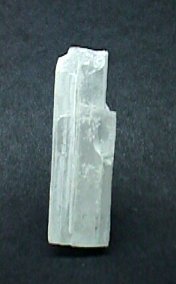The Mineral kernite

Kernite was first discovered in 1926 in the Kramer District in Boron, California, in an enormous, underground deposit. Almost immediately, its commercial importance was recognized and it became the most significant source of the chemical borax, becoming an even greater ore than the mineral Borax itself. Many more Kernite deposits probably exist deep below the surface in large borate deposits, and when discovered can be of economic importance.
Kernite does not keep well in collections, being that it is efflorescent, meaning it loses the water in its crystal structure if not stored properly. Effects of efflorescence are the appearance of white powder on the surface and formation of cloudy cracks, which cause the specimen to become opaque and dull. In severe cases of efflorescence, Kernite crumbles into a white powder.
Chemical Formula
Na2B4O7 ·
4H2O
Color
Colorless, white, light gray
Crystal System
Monoclinic
Properties
Streak
White |
Hardness
3 |
Transparency
Transparent to opaque |
Specific Gravity
1.9 - 2.0 |
Luster
Vitreous, silky, dull |
Cleavage
1,1 - prismatic |
Fracture
Splintery |
Tenacity
Brittle |
Other ID Marks
1) Soluble in water.
2) Has a sweetish, metallic taste.
3) Develops a white powder on its surface upon prolonged exposure to air. |
Uses
After its discovery, Kernite became the principle source of borax and other boron compounds. It yields more of the chemical borax than the actual mineral Borax, since it contains less water than the mineral Borax.
Noteworthy Localities
The initial discovery of Kernite was in a deposit several hundred feet below the earth in Boron, in the Kramer District, Kern Co., California. For a long time, it was the only occurrence of this mineral. Enormous masses, some reaching 30 feet (9 meters) were obtained from there. Other Kernite deposits exist in the Tincalayu Mine, Salta, Argentina; and in Kirka, Turkey.
Common Mineral Associations
Borax, Colemanite, Ulexite
Distingushing Similar Minerals
The taste and occurences of Kernite can distinguish it from any mineral.